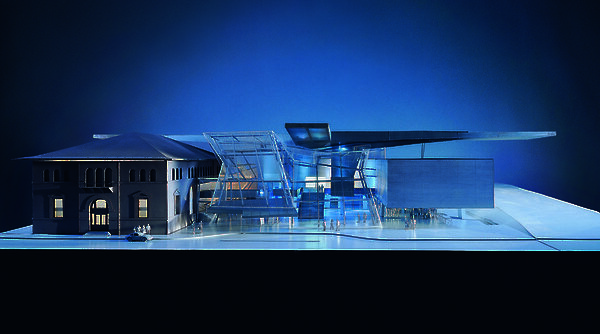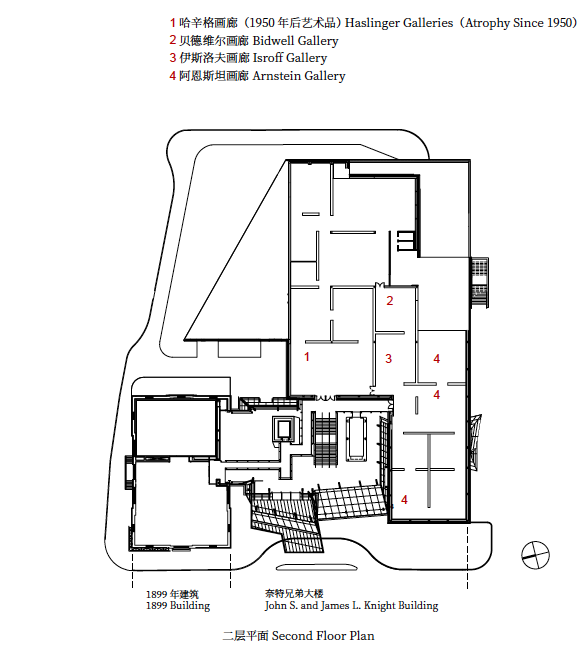
设计单位 蓝天组建筑事务所
项目地点 美国俄亥俄州
建成时间 2007年
使用面积 8244平方米
本文文字由设计单位提供。
博物馆的概念来源于16世纪,鲁道夫二世和费迪南德二世的珍奇屋“Wunderkammer”,并且随着时代发展,其含义不断更新。蓝天组通过阿克伦艺术博物馆,发展了一个新的博物馆概念:“未来博物馆”。
The concept of museums has changed radically since the cabinet of curiosities "Wunderkammer" of Rudolf II and Ferdinand II in the 16th century. With the Akron Art Museum, we developed a new museum concept: "a Museum of the Future".




“今天的博物馆不再只是一个储存和展示知识的机构,它是一个城市概念。”
"The museum of today is no longer conceived only as an institution for storage and display of knowledge, it is an urban concept."
——沃尔夫· 狄· 普瑞克斯 Wolf D. Prix
博物馆和城市空间的结合,共同形成了新型文化中心。
The conventional functions of a museum and an urban space form together a new type of cultural center.
未来博物馆是城市中的一个三维标志,展示着我们的视觉世界。它们不仅仅是各种形式的数字信息和模拟视觉信息的展览空间,还可以作为一种城市体验空间。这意味着,艺术应该能够从建筑中流出,城市也应该能够流入其中。
The museum of the future is a three-dimensional sign in the city, which exhibits the content of our visual world. More than exhibition spaces that display diverse forms of digital and analog visual information, they function as spaces that cater to urban experiences. This means that art should be able to flow out of the building, and the city to flow inside.

这个区域变成了一个多功能空间,各种类型的人都可以在这里见面并不定期地举办各种活动。它鼓励人们不是仅仅为了欣赏艺术而来访,还可以在此参与艺术讨论、参加音乐会和艺术节,或者只是到这里逛逛,打发零星的时间。因此,我们的设计既是一个城市连接器,也是一个目的地。
This zone becomes a hybrid space where various types of people can meet and unexpected events occur. Rather than going to the museum simply to look at art, visitors are encouraged to engage in artistic discourse, attend music and arts festivals, or simply pass the time until an appointment. Our design is therefore an urban connector as well as a destination point.

阿克伦艺术博物馆是对现有博物馆结构的扩建,由三部分组成:水晶体结构、中心画廊和云屋顶。
The building, an addition to an existing museum structure, is comprised of three parts: the Crystal, the Gallery Box, and the Roof Cloud.



水晶体部分作为主入口,起到了连接新老建筑与引导的作用,它宽敞、灵活,可以为其他机构提供场地,用于举办宴会、艺术节等各种活动。
The Crystal, which is the main entrance, provides orientation and connection between the old and new parts of the building. It is the access area for public resources such as the lecture hall, classroom, library, café, and bookstore.



中心画廊的内部空间宽敞、柱子极少,布局非常灵活,可以满足不同的展览需求。一台大型的货运电梯将卸货区与画廊连接起来,方便超大尺寸的作品进出仓储区域。画廊中没有自然采光,避免了阳光对展品的破坏。且使得空间内的光环境得到了严格的控制。
The interior of the Gallery Box is an expansive space that has very few columns and is therefore extremely flexible for varying exhibition requirements. A large freight elevator brings oversized works to and from the storage areas and serves as a link between the loading dock and the Gallery Box. Natural light is eliminated in the galleries so that it can be strictly controlled, and damage from sunlight can be eliminated.

悬于建筑上方的云屋顶以其物质体量的纯粹,模糊了博物馆建筑的边界。同时,作为城市的一座水平地标,它围合着室内空间并为室外环境提供荫蔽。
The Roof Cloud, which hovers above the building, creates a blurred envelope for the museum because of its sheer mass and materiality. It encloses interior space, provides shade around the museum, and operates as a horizontal landmark in the city.



通过有策略地控制建筑体量以及利用日照,水晶体部分因照明、采暖及降温所消耗的能源被降到了最低。水晶体部分利用区域微气候的理念来调节温度,将能源集中用于人员所在的区域而不是整个空间,以此显著降低运作成本以及能耗。
The necessary energy for lighting, heating, and cooling of the Crystal is minimized by strategic positioning of thermal mass in conjunction with extensive daylighting. The lobby utilizes microclimate zones as a heating and cooling concept. These different zones are determined by analyzing the type and anticipated length of occupancy in various areas of the Crystal and are conditioned through optimization of active and passive means. By eliminating the need to condition the entire air volume in the Crystal, and by focusing the energy used to condition the space in the areas where people are located, operating costs and energy use are significantly reduced.

中心画廊与水晶体部分的楼板由铺设了冷热水管的现浇混凝土制成,并以此来调节室内温度。这种地板辐射系统比简单的强制空气调节系统更高效,因为它使用混凝土本身作为储热设备,为室内提供了一个稳定、持续的温控源。
The Crystal and gallery floors are composed of poured in place concrete slabs with water-filled tubes that supply heating and cooling by changing the temperature state of the massive floor slab. This radiant floor system is more efficient than simple forced air systems because it uses the mass of the concrete as a storage device that delivers a stable continuous source of heating and cooling.
中心画廊和高屋顶的体量与位置使南向的水晶体免受阳光直射。同时,幕墙材料的反射率提高了水晶体中的自然光水平,降低了人工照明的需求。
The mass and location of the Gallery Box and Roof Cloud protect the southern oriented Crystal glazing from direct sunlight. At the same time, the reflectivity of the façade material raises natural light levels in the Crystal and reduces the need to power artificial light sources.



设计图纸 ▽







完整项目信息
业主:Akron Art Museum, Akron, Ohio, USA
规划设计:蓝天组建筑事务所 COOP HIMMELB(L)AU—Wolf D. Prix, Helmut Swiczinsky+Partner ZT GmbH
主持设计师:沃尔夫· 狄· 普瑞克斯 Wolf D. Prix
项目合伙人:Michael Volk
建筑设计师:Tom Wiscombe, Mona Marbach
项目建筑师:Angus Schoenberger
团队成员:Mona Bayr, Marcelo Bernadi, Lorenz Bürgi, Mohamed Fezazi, Robert Haranza, Daniela Kobel, Dan Narita, Florian Pfeifer, Dionicio Valdez, Philip Vogt
执行建筑师:Westlake, Reed, Leskosky, Cleveland,Ohio, USA
结构工程:B+G Ingenieure, Bollinger and Grohmann GmbH, Frankfurt, Germany; De Simone ConsultingEngineers, San Francisco, USA
机械工程:IBE Consulting Engineers, Los Angeles, USA
声学工程:Arup Acoustics, New York, USA
照明设计:George Sexton Associates, Washington DC, USA
影像:©COOP HIMMELB(L)AU, ©Roland Halbe
项目大事记:竞赛(首奖)—2001年;项目规划启动—2002年;工程启动—2004年;项目启用—2007年
基地面积:8,370平方米
总使用面积:8,244平方米
改造建筑使用面积:2,367平方米
新建建筑使用面积:5,877平方米
原有博物馆高度:16.76米
新建建筑高度:中心画廊—11.25米;屋顶—17.5米;水晶体结构—17.5米
建筑长度最大值:76米(中心画廊)
建筑宽度最大值:38米(中心画廊)
本文由蓝天组建筑事务所授权有方发布。欢迎转发,禁止以有方编辑版本转载。
上一篇:新开发银行总部大楼 | 华东建筑设计研究院
下一篇:阿喜茶楼,喜茶广州LAB店 / 立品设计